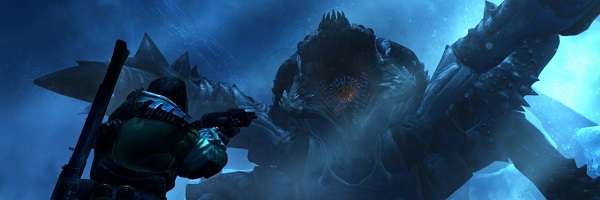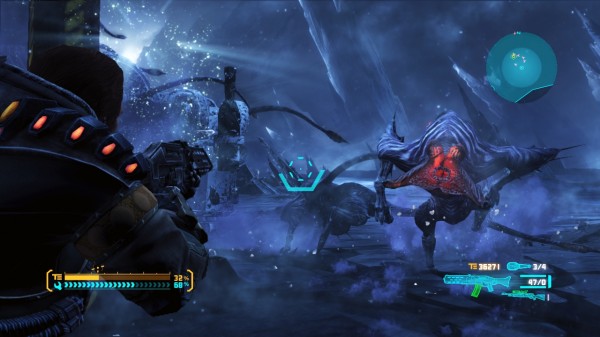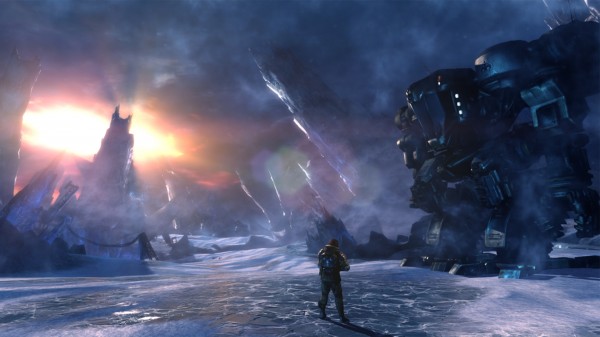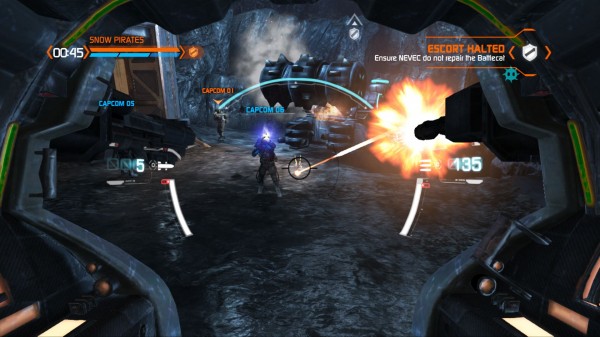
Lost Planet 3 Xbox 360 Review
The Lost Planet series and I have had our shares of ups and downs. I adored the first game, but loathed the second. When the original game released on the Xbox 360 there was a sense of “next-gen” about it – the gorgeous looking ice world, the grappling hook mechanic, huge, exhilarating monster battles, and of course, you could pilot a mecha-like robot. Lost Planet was a cool (pardon the pun) and exciting third-person shooter. Then Lost Planet 2 arrived and I was hugely disappointed in the direction Capcom had taken the sequel. The single player was the main reason why I loved Lost Planet, so to have that stripped away and replaced with a focus on cooperative play, well, you can imagine my upset. Sure, Lost Planet 2 was fun with friends, but I felt that the smaller stages were broken up too much. Now we’re on to the third instalment, created by a different development team, Spark Unlimited, who doesn’t exactly have a proven track record (Legendary, Turning Point: Fall of Liberty), but after playing through Lost Planet 3, I can safely say that this slots in between the greatness of the first game and the lacklustre Lost Planet 2.
Lost Planet 3 is set roughly 50 years before Lee Byung-hun (great actor, you should watch I Saw the Devil) ever touched ice in Lost Planet. The game’s protagonist is one Jim Peyton, a normal guy who has moved to E.D.N. III to help NEVEC mine resources from the planet. It also pays well, so Jim uses this opportunity to support his family back at home by sending them money. The game starts with an old Jim trapped under a rock, as the game uses flashbacks to allow the player to take part in the action while Jim explains to his buddy the life spent on E.D.N. III and the hardship he had to go through.

The story is very run-of-the-mill and filled to the brim with clichés that you’ve seen in films with similar settings – ones that involve corporations with secret agendas to steal the resources on whatever planet it takes place on. For Lost Planet 3, this means the capture of T-Energy, which fans will know about already, thanks to its orange glowing appearance in the past two games. Fans will also know the name of NEVEC as well, the antagonist army of the first game, who is in its innocence stage, as you slowly see them transforming into the company that will soon become the adversary.
What I was pleasantly surprised by is how I felt for Jim. The Lost Planet franchise isn’t known for its story telling or character development, and while Lost Planet 3 won’t win any Oscar nominations for its acting, it was unexpected to see the focus on characters here. Virtually all the characters in Lost Planet 3 are normal, everyday guys. There is nothing special about them; they have beards, hair and are trying to survive an extreme climate with technology that hardly works. With Jim, it’s different because of the developers building his relationship with his wife. This is done during loading screens or quiet, exploration parts of the game, where a video pops up with Jim’s wife talking about her daily happenings down on Earth. Jim’s replies are also exhibited, so you get to see plenty of one-sided messaging between Jim and his wife. It’s a small thing, but it builds up his charm and it leads to touching moments between the two characters, even though they are never communicating with each other in real time.

Early on, fans will notice that there’s a drastic change with Lost Planet 3’s pacing and structure. Rather than having levels that progress on, like a straight-forward third-person shooter, Lost Planet 3 has a base, which features shops, side quests, NPCs to interact with, but above all it has a map that you repeatedly explore and open up further as you progress through the game – it’s a somewhat open experience. Now, it’s not open world to the point that the map is huge, rather it’s simply having you explore the vast tundra and its habitants as it tries to build up a convincing world by putting the players in Jim’s shoes and letting them explore the surroundings that are situated around the main base.
The start of the game is slow, building up the concept of Jim the mechanic, so you’re fixing frozen machinery and exploring the territory. But as you get further in, the game is always pushing you into new locations, opening more of the map for the player to explore. Thankfully, there is a teleport system in place that allows Jim to instantly travel. This stops players having to experience the dreaded load screen, since the map is split into many sections and early on you are forced to stand through those load screens. In sense, this map design feels like it was created to let the developers slot in side-quests. Side-quests are straightforward, often given objectives as killing specific Akrids, taking samples of eggs or collecting some T-Energy. They do open up more weaponry for the player, but apart from the initial introduction, you’re never forced to take them on. It also wouldn’t be a shooter without some sort of collectibles. In Lost Planet 3, these are audio and text logs that build on the backstory – nothing too exciting.

Due to the time period Lost Planet 3 takes place in, the design of the Vital suit is no longer focused on military assault. Instead, these machines, known as Utility Rigs, are made for traversing and mining the landscape of E.D.N. III. You’ll spend a lot of time riding in Rigs – which shift the view into a first-person perspective, a first for the series – when you are moving between the mission points. Rigs are slow machines that lack any sort of guns, armed only with claws, grappling hooks and drills. This makes them horrid for defending against Akrid attacks. In fact, I found it painfully frustrating and monotonous to fight them in the machines. I mostly opted to get out (when allowed) and use Jim’s own arsenal of weapons. This is because most of the mini-boss fights are just time-based quick-time-events, where you wait – and I do mean wait, it can be annoying just staring at the Akrid, while waiting for it to pounce – for the button prompt to appear, press it, then press another button and then press another button to drill its weak point. It’s not engaging, and is completely the opposite of what was so cool about Lost Planet and its arsenal of boost-fuelled war machines.
At least the third-person action is solid. The distinct feel of the old Lost Planet games is gone, replaced now with Unreal Engine 3. If you’ve played any third-person shooter built with that engine, then you’ll have a good idea of the camera view and action you are getting in Lost Planet 3. One of the biggest changes to the combat is the reduced access to the grappling hook, a key feature for the franchise, which is now locked to context sensitive glowing points on cliff edges. This means you can no longer randomly attach to objects, removing the joy the grappling mechanic brought in the past. T-Energy is no longer needed to stay alive (health also regenerates, with the red on screen acting as indication of death approaching) as any T-Energy found is now used for money to spend on upgrades for your Rig and Weaponry. Guns are mostly the standard shotguns, rifles, pistols, although the crossbow with explosive arrows is a joy to play with. Akrids still have the same glowing orange weak points, so you always know where you must shoot to kill.

One thing that seems evident is that some areas of the game are obviously inspired by Dead Space and films such as The Thing. I found this a little strange, because Lost Planet has never been the one to induce a sense of tension or fear, but the indoor sections that feature in the abandoned colony structures are certainly built this way, especially when the soundtrack is trying its hardest to build up the tension with sharp, threatening notes. It doesn’t work, as the enemies and action isn’t suited for it. Akrids are limited in variety, and you’ll often fight the same ones time and time again. Props when given though, because they all attack in various ways from the standard “rush at human” A good example of this is a species of Akrid that pop their heads up and snipe from behind boxes with their needle shots. The same species has a spin-off, where they only attack by running up to Jim, hitting him, and then running away to cover, as if it’s trolling the player, similar to those old-school Tango adverts.
Boss fights were a highlight for Lost Planet, especially the second game, but for this prequel the scale has been dramatically reduced. There are still some towering bosses, but fighting them never feels exhilarating, especially when using a Rig. I also don’t like the reuse of bosses. It just took the wind out of me when I knew I had to repeat the same process I did just an hour ago in the same tedious way.

Multiplayer makes a return with 5 vs. 5 team-based modes across six maps. It should also be noted that the Rigs don’t exist in the multiplayer; thankfully, they are replaced by the Vitals, meaning you can jump into a machine and enjoy the fun of blasting people with huge machine guns. The grappling hook is also given more freedom, with many points accessible to grab on. Competitive modes include Team Deathmatch, Extraction (similar to the old games, where you take over data posts and gain points), and Scenario, an objective-focused mode where one team usually has to do a task and the other team stops them. The Akrid Survival mode is 3 vs. 3, where both teams fight off waves of Akrid to gain points. When the timer begins to draw towards the end of the match, a zone is highlighted for capture. In here, teams fight each other to take it over and gain additional bonus points. It’s a fun mode with a twist, and the multiplayer as a whole is enjoyable, but nothing stimulating that will keep you interested for the months to come.
Unreal Engine 3 helps Lost Planet 3 represent the devilish nature of a planet wrapped in ice. Some of the vistas are gorgeous, especially one area near a storm that overlooks a canyon with mountainous ice spikes protruding from the ground and lightning storms raging in the distance. Lost Planet 3 can be pretty game, but some areas do look better than others. Load times spoil the transition between zones and the frame rate does drop often from its 30FPS target. It’s a game that screams to be played on PC, so if that is an option, then do it.

Lost Planet 3 is a peculiar game. It’s a solid third-person shooter with an identity crisis. Some of the changes to the single player won’t go down so well with the fans – it’s missing some of the bits that gave Lost Planet its own personality. At least they tried to give it a coherent story this time around, even if as a whole it isn’t well-told. There are too many issues, such as the awful Rig combat, congested pacing and lack of versatility in the combat to be a recommendation, but if you were soured how Lost Planet 2 turned out, then you might enjoy this return to a single-player focus.
